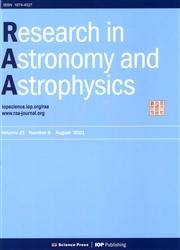Design and Application of an S-band Fast Radio Bursts Search Pipeline for the Nanshan 26 m Radio Telescope
IF 2.8
4区 物理与天体物理
Q3 ASTRONOMY & ASTROPHYSICS
引用次数: 0
Abstract
Fast radio bursts (FRBs) are among the most studied radio transients in astrophysics, but their origin and radiation mechanism are still unknown. It is a challenge to search for FRB events in a huge amount of observational data with high speed and high accuracy. With the rapid advancement of the FRB research process, FRB searching has changed from archive data mining to either long-term monitoring of the repeating FRBs or all-sky surveys with specialized equipments. Therefore, establishing a highly efficient and high quality FRB search pipeline is the primary task in FRB research. Deep learning techniques provide new ideas for FRB search processing. We have detected radio bursts from FRB 20201124A in the南山 26 米射电望远镜 S 波段快速射电暴搜索管道的设计与应用
快速射电暴(FRBs)是天体物理学中研究最多的射电瞬变现象之一,但其起源和辐射机制仍然未知。如何在海量观测数据中高速、高精度地搜索FRB事件是一项挑战。随着 FRB 研究进程的快速推进,FRB 搜寻已经从档案数据挖掘转变为对重复 FRB 的长期监测或利用专业设备进行全天空巡天。因此,建立高效、高质量的 FRB 搜索管道是 FRB 研究的首要任务。深度学习技术为 FRB 搜索处理提供了新思路。我们在南山26米射电望远镜(NSRT-26m)的L波段观测数据中,利用构建的基于深度学习的搜索管道--分散动态谱搜索(DDSS),探测到了FRB 20201124A的射电暴。之后,我们进一步重新训练了深度学习模型,并将 DDSS 框架应用于 S 波段观测。本文介绍了使用 S 波段接收机的 FRB 观测系统和搜索管道。我们进行了搜索实验,并成功探测到了来自磁星 SGR J1935+2145 和 FRB 20220912A 的射电暴。实验结果表明,搜索管道能够高效地完成搜索,并输出高精度的搜索结果。
本文章由计算机程序翻译,如有差异,请以英文原文为准。
求助全文
约1分钟内获得全文
求助全文
来源期刊

Research in Astronomy and Astrophysics
地学天文-天文与天体物理
CiteScore
3.20
自引率
16.70%
发文量
2599
审稿时长
6.0 months
期刊介绍:
Research in Astronomy and Astrophysics (RAA) is an international journal publishing original research papers and reviews across all branches of astronomy and astrophysics, with a particular interest in the following topics:
-large-scale structure of universe formation and evolution of galaxies-
high-energy and cataclysmic processes in astrophysics-
formation and evolution of stars-
astrogeodynamics-
solar magnetic activity and heliogeospace environments-
dynamics of celestial bodies in the solar system and artificial bodies-
space observation and exploration-
new astronomical techniques and methods
 求助内容:
求助内容: 应助结果提醒方式:
应助结果提醒方式:


